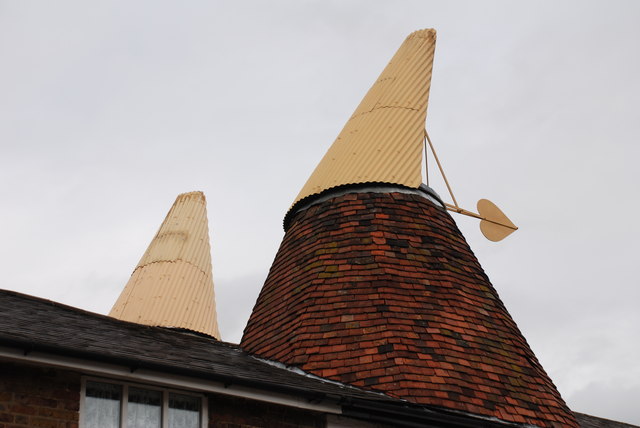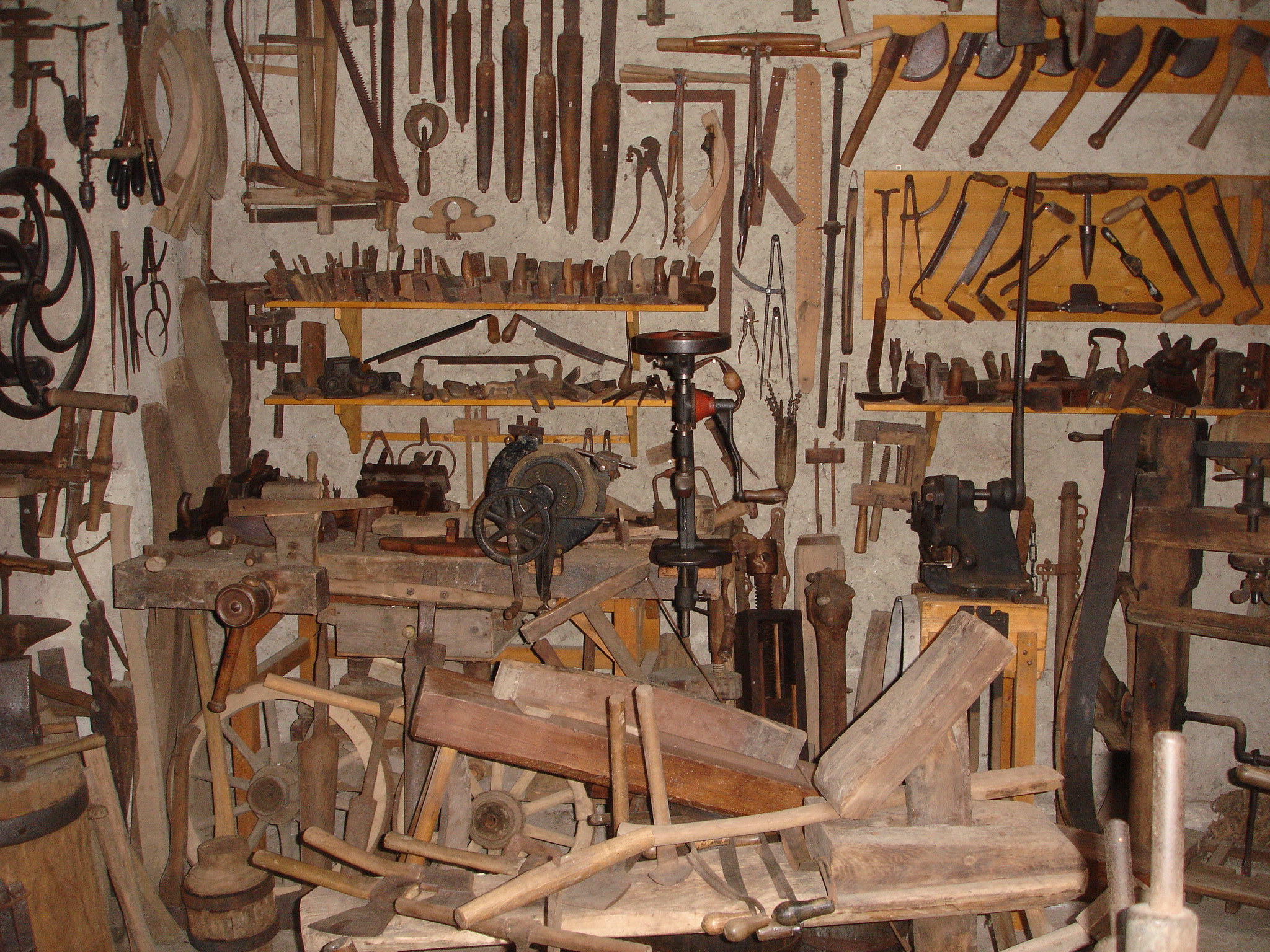|
Cowl (oast)
A cowl is a device used on a kiln to keep the weather out of and to induce a flow of air through the kiln. They are normally associated with oasts but can also be found on breweries (Letheringsett, Norfolk), maltings (Ware, Hertfordshire; Hadlow, Kent) and watermills (East Linton, East Lothian). Construction This section deals with the traditional cowls found on oasts, with particular reference to the South East. From the outside, a cowl appears to just sit on the roof of the kiln. High in the roof of the kiln is a beam spanning the centre, called the ''sprattle beam'', this carries a bearing which the gudgeon, pintle on the bottom of the ''centre post'' sits in. At the top of the kiln, the centre post passes through a two or three armed ''top stay iron''. At the top of the centre post is carried the ''back board'' which carries an elm ''curb ring'' at the bottom, and one or two curb rings higher up on all except the smallest of cowls. A ''tie beam'' could also be carried, either ... [...More Info...] [...Related Items...] OR: [Wikipedia] [Google] [Baidu] |
Oast Cowl
An oast, oast house (or oasthouse) or hop kiln is a building designed for kilning (drying) hops as part of the brewing process. Oast houses can be found in most hop-growing (and former hop-growing) areas, and are often good examples of agricultural vernacular architecture. Many redundant oast houses have been converted into houses. The names "oast" and "oast house" are used interchangeably in Kent and Sussex, but in Surrey, Hampshire, Herefordshire and Worcestershire they are called "hop kilns". An oast house consists of a rectangular one- or two-storey building (the "stowage") and one or more kilns in which the hops were spread out to be dried by hot air rising from a wood or charcoal fire below. The drying floors were thin and perforated to permit the heat to pass through and escape through a cowl (oast), cowl in the roof which turned with the wind. The freshly picked hops from the fields were raked in to dry and then raked out to cool before being bagged up and sent to the bre ... [...More Info...] [...Related Items...] OR: [Wikipedia] [Google] [Baidu] |
Copper
Copper is a chemical element; it has symbol Cu (from Latin ) and atomic number 29. It is a soft, malleable, and ductile metal with very high thermal and electrical conductivity. A freshly exposed surface of pure copper has a pinkish-orange color. Copper is used as a conductor of heat and electricity, as a building material, and as a constituent of various metal alloys, such as sterling silver used in jewelry, cupronickel used to make marine hardware and coins, and constantan used in strain gauges and thermocouples for temperature measurement. Copper is one of the few metals that can occur in nature in a directly usable, unalloyed metallic form. This means that copper is a native metal. This led to very early human use in several regions, from . Thousands of years later, it was the first metal to be smelted from sulfide ores, ; the first metal to be cast into a shape in a mold, ; and the first metal to be purposely alloyed with another metal, tin, to create bronze, ... [...More Info...] [...Related Items...] OR: [Wikipedia] [Google] [Baidu] |
Richard Rogers
Richard George Rogers, Baron Rogers of Riverside (23 July 1933 – 18 December 2021) was a British-Italian architect noted for his modernist and constructivist designs in high-tech architecture. He was the founder at Rogers Stirk Harbour + Partners, previously known as the Richard Rogers Partnership, until June 2020. After Rogers' retirement and death, the firm rebranded to simply RSHP on 30 June 2022. Rogers was perhaps best known for his work on the Pompidou Centre in Paris, the Lloyd's building and Millennium Dome, both in London, the Senedd building, in Cardiff, and the European Court of Human Rights building, in Strasbourg. He was awarded the RIBA Gold Medal, the Thomas Jefferson Medal, the RIBA Stirling Prize, the Minerva Medal, and the 2007 Pritzker Prize. Early life and career Richard Rogers was born in Florence, Tuscany, in 1933 into an Anglo-Italian family. His father, William Nino Rogers (1906–1993), was Jewish, and was the cousin of Italian Jewish archi ... [...More Info...] [...Related Items...] OR: [Wikipedia] [Google] [Baidu] |
Preston Mill
Preston Mill is a watermill on the River Tyne at the eastern edge of East Linton on the B1407 Preston Road, in East Lothian, Scotland, UK. It is situated close to Prestonkirk Parish Church, the Smeaton Hepburn Estate, Smeaton Lake, and Phantassie Doocot. It is a Category A listed building. Preston is a hamlet adjacent to East Linton, East Lothian, Scotland. There has been a mill on the site since the 16th century. The present mill dates from the 18th century and is in the care of the National Trust for Scotland. It was used commercially until 1959, and it produced oatmeal. The River Tyne still drives the water wheel, and the machinery can still be seen at work by visitors taking part in a tour. There is also an exhibition about milling, and a mill pond. The engineer and millwright Andrew Meikle maintained the mill in the 18th century. In 1948 a flood submerged the buildings, and in 1950 a local land owner gave the mill to the National Trust for Scotland. The milling firm ... [...More Info...] [...Related Items...] OR: [Wikipedia] [Google] [Baidu] |
Mortise And Tenon
A mortise and tenon (occasionally mortice and tenon) is a Woodworking joints, joint that connects two pieces of wood or other material. Woodworking, Woodworkers around the world have used it for thousands of years to join pieces of wood, mainly when the adjoining pieces connect at right angles, though it can be used to connect two work pieces at any angle. Mortise-and tenon-joints are simple, strong, and stable, and can be used in many projects and which give an attractive look. They are either glued or friction-fitted into place. This joint is difficult to make, because of the precise measuring and tight cutting required; as such, modern woodworkers often use machinery specifically designed to cut mortises and matching tenons quickly and easily. Still, many woodworkers cut them by hand in a traditional manner. There are many variations of this type of joint, but its basic structure has two components, the ''mortise'' hole and the ''tenon'' tongue. The tenon, formed on the end o ... [...More Info...] [...Related Items...] OR: [Wikipedia] [Google] [Baidu] |
Pulley
Sheave without a rope A pulley is a wheel on an axle or shaft enabling a taut cable or belt passing over the wheel to move and change direction, or transfer power between itself and a shaft. A pulley may have a groove or grooves between flanges around its circumference to locate the cable or belt. The drive element of a pulley system can be a rope, cable, belt, or chain. History The earliest evidence of pulleys dates back to Ancient Egypt in the Twelfth Dynasty (1991–1802 BC) and Mesopotamia in the early 2nd millennium BC. In Roman Egypt, Hero of Alexandria (c. 10–70 AD) identified the pulley as one of six simple machines used to lift weights. Pulleys are assembled to form a block and tackle in order to provide mechanical advantage to apply large forces. Pulleys are also assembled as part of belt and chain drives in order to transmit power from one rotating shaft to another. Plutarch's ''Parallel Lives'' recounts a scene where Archimedes proved the effectiveness ... [...More Info...] [...Related Items...] OR: [Wikipedia] [Google] [Baidu] |
Rope
A rope is a group of yarns, Plying, plies, fibres, or strands that are plying, twisted or braided together into a larger and stronger form. Ropes have high tensile strength and can be used for dragging and lifting. Rope is thicker and stronger than similarly constructed cord, String (structure), string, and twine. Construction Rope may be constructed of any long, stringy, fibrous material (e.g., rattan, a natural material), but generally is constructed of certain natural fibre, natural or synthetic fibre, synthetic fibres. Synthetic fibre ropes are significantly stronger than their natural fibre counterparts, they have a higher tensile strength, they are more resistant to rotting than ropes created from natural fibres, and they can be made to float on water. But synthetic ropes also possess certain disadvantages, including slipperiness, and some can be damaged more easily by UV light. Common natural fibres for rope are Manila hemp, hemp, linen, cotton, coir, jute, straw, an ... [...More Info...] [...Related Items...] OR: [Wikipedia] [Google] [Baidu] |
Wheelwright
A wheelwright is a Artisan, craftsman who builds or repairs wooden wheels. The word is the combination of "wheel" and the word "wright" (which comes from the Old English word "''wryhta''", meaning a worker - as also in shipbuilding, shipwright and arkwright). This occupational name became the English surname ''Wright'', and also appears in surnames like ''Cartwright'' and ''Wainwright''. These tradesmen made wheels for carts (cartwheels), wagons (wains), traps and coaches. They also made the wheels, and often the frames, for spinning wheels, and the belt drives of steam powered machinery. First constructing the hub (called the nave), the spokes and the rim segments called felloes, and assembling them all into a unit working from the center of the wheel outwards. Most wheels were made from wood, but other materials have been used, such as bone and horn (anatomy), horn, for decorative or other purposes. Some earlier construction for wheels such as those used in early chariots wer ... [...More Info...] [...Related Items...] OR: [Wikipedia] [Google] [Baidu] |
Density
Density (volumetric mass density or specific mass) is the ratio of a substance's mass to its volume. The symbol most often used for density is ''ρ'' (the lower case Greek letter rho), although the Latin letter ''D'' (or ''d'') can also be used: \rho = \frac, where ''ρ'' is the density, ''m'' is the mass, and ''V'' is the volume. In some cases (for instance, in the United States oil and gas industry), density is loosely defined as its weight per unit volume, although this is scientifically inaccurate this quantity is more specifically called specific weight. For a pure substance, the density is equal to its mass concentration. Different materials usually have different densities, and density may be relevant to buoyancy, purity and packaging. Osmium is the densest known element at standard conditions for temperature and pressure. To simplify comparisons of density across different systems of units, it is sometimes replaced by the dimensionless quantity "relative den ... [...More Info...] [...Related Items...] OR: [Wikipedia] [Google] [Baidu] |
Convection
Convection is single or Multiphase flow, multiphase fluid flow that occurs Spontaneous process, spontaneously through the combined effects of material property heterogeneity and body forces on a fluid, most commonly density and gravity (see buoyancy). When the cause of the convection is unspecified, convection due to the effects of thermal expansion and buoyancy can be assumed. Convection may also take place in soft solids or mixtures where particles can flow. Convective flow may be Transient state, transient (such as when a Multiphasic liquid, multiphase mixture of oil and water separates) or steady state (see convection cell). The convection may be due to Gravity, gravitational, Electromagnetism, electromagnetic or Fictitious force, fictitious body forces. Convection (heat transfer), Heat transfer by natural convection plays a role in the structure of Earth's atmosphere, its oceans, and its Earth's mantle, mantle. Discrete convective cells in the atmosphere can be identified by ... [...More Info...] [...Related Items...] OR: [Wikipedia] [Google] [Baidu] |







